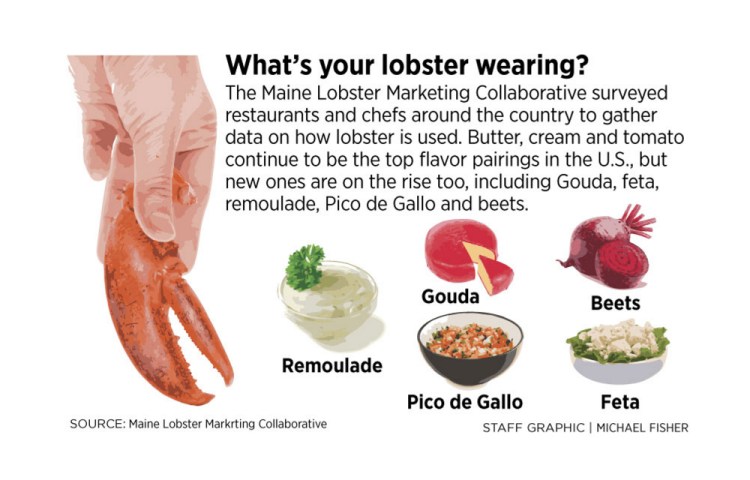Serving up Maine lobster is paying off big for restaurants that tout the state’s iconic offering on their menus.
Restaurants selling lobster are charging $6.22 more, on average, when it comes from Maine and its provenance is identified by name on the menu, according to a new report issued Tuesday by the Maine Lobster Marketing Collaborative. The Portland-based nonprofit, which was founded in 2013 and is funded by industry license surcharges, based its finding on a 2015 menu survey of about 7,000 American restaurants conducted by Technomic Inc., a food consulting and research firm based in Chicago, said Executive Director Matt Jacobson.
“There’s lobster, and then there’s Maine lobster,” Jacobson said. “People are willing to pay for that difference. Not just pennies more, but $6 more a plate, plus. Chefs are drawn to the taste, the story and sustainability of Maine lobster. When chefs like to cook it, customers are willing to pay for it. That’s good for everybody, including the lobstermen.”
The Technomic data contained in the collaborative’s first quarterly report proves what many in the industry have long suspected, but couldn’t prove because of a lack of consumer research, especially in the domestic market, Jacobson said. It will serve as another tool in the collaborative’s arsenal when it begins its summer-long campaign to convince chefs to add Maine lobster to their menus. Only a quarter of all restaurants identify the origin of their lobster dishes, he said, but most of those who do are selling Maine lobster.
Last summer, when the cooperative began its Maine lobster education campaign, the organization arranged a series of “collisions” between what Jacobson calls rock-star chefs, who tend to set the culinary tone in local foodie markets, and Maine lobstermen. Sometimes the collaborative brought chefs out on a Maine lobster boat, but usually, the collaborative brought one of Maine’s lobster harvesters into the kitchens of some of the best restaurants in the country for cooking demonstrations, recipe sharing and story telling.
“Every single chef ended up putting Maine lobster on their menu,” Jacobson said. “They couldn’t resist the taste, the versatility, but especially the stories. In a food-to-table world, or boat-to-table, that really matters.”
As examples, Jacobson ticked off two high-profile New York City restaurants – Craft New York with chef Tom Colicchio and Bar Americain with chef Bobby Flay – that added Maine lobster to their menus after collisions arranged by the collaborative. When they did, other restaurants in the city, and those in other trendy food markets, followed.
LOW PRICES LED TO MARKETING PUSH
The Maine Legislature established the marketing cooperative in 2013 after the average price of the state lobster catch sank to $2.69 per pound, the lowest in nearly two decades caused by an unseasonably warm spring and an ensuing lobster glut. Last year, the lobster catch was valued at nearly $500 million – a record.
The collaborative decided to focus its effort on pushing the Maine brand domestically, even in its home state, where Jacobson said many restaurants, and residents, take Maine lobster for granted. But Jacobson suspects that even Maine restaurants could probably benefit from touting the state label, which would reinforce the brand value among the many tourists that visit Maine each summer.
He pointed to The Clam Shack in Kennebunkport as an example of a Maine restaurant that has begun advertising its use of locally sourced lobsters.
The collaborative will organize more chef-lobstermen collisions over the summer in Atlanta, New York City and Washington, D.C., Jacobson said. At these events, the Maine contingent will be touting the benefits of Maine lobsters with their soft shells and sweet, briny taste. But they will be using the term “new shell” to describe the just-molted lobster that accounts for 70 percent of the state catch.
While Maine fishermen are permitted to catch lobsters in state waters year-round, they mainly harvest them in the summer and early fall after the crustaceans move closer to shore and crawl out of their tight-fitting shells. It takes a molted lobster months to grow a new shell and have it harden. The lobsters in the summer are easier to catch, too, because they’re closer to shore, hungrier and move around more. State lobster advocates say “new shell” lobster is more tender and tastes sweeter.
FROM CHIC TO FAST FOOD
Canadian lobstermen harvest the same species over the winter in deeper waters, when their shells are hard and hold more meat. Hard-shell lobster fetches fishermen as much as $3 more per pound than soft-shelled lobster.
In the future, Jacobson would like to get more detailed data from Technomic to learn whether restaurants of all price points charged more for Maine lobster, or if it is just upscale restaurants, which generally charge more for dishes anyway. But he noted that even Pret a Manger, a fast-food chain based in the United Kingdom, put Maine lobster rolls on its menus, so the appeal of the brand and the taste is not limited to the Michelin star crowd.
The Technomic data isn’t perfect, either, he noted. For example, many restaurants offer Maine lobster dishes as a special, which are frequently written on a chalkboard, and may not be picked up by a national menu survey.
Jacobson would like to have Technomic mine its menu survey data for information about how the use of the “new shell” label affects menu price, but he doesn’t think the sample size is big enough yet to have statistical value. If he has a summer full of fruitful collisions, however, that may change next year.
Send questions/comments to the editors.



Comments are no longer available on this story